One of the most ancient city Jaipur often popularly called as Pink City, where you feel Royalness in culture & architectural beauty in physical ecosystem. This amazing city have countless adorable forts and grand ancient buildings and adorable temples, that can fascinate anyone. This pride city is also the capital of Rajasthan, India. It was constructed by Maharaja Sawai Jai Singh II in 1727. From numerous incredible buildings to its busy markets, selling traditional crafts, fabrics, and jewellery, everywhere you can feel unique pleasure. The City Palace, Amber Fort, and Jantar Mantar observatory are must-see places. Jaipur hosts colorful festivals, offers delicious food, and welcomes visitors warmly, making it a charming and regal destination to explore.
History Of Jaipur, Rajasthan

In the heart of Rajasthan’s desert lands Jaipur, the capital of Rajasthan, India, was founded in 1727 by Maharaj Sawai Jai Singh II. He moved the capital from Amber to Jaipur due to population growth and water scarcity. Designed according to Vastu Shastra principles with the help of architects, the city was painted pink in 1876 to welcome Prince Albert Edward. By the 19th century, it became a bustling city with a population of 160,000 and thriving metal and marble industries. In 2019, Jaipur was designated as a World Heritage City.
Places To Visit In Jaipur, Rajasthan
Jaipur, the capital city of Rajasthan, is known for its great history, vibrant culture and adorable architecture. Here are some of the top places to visit in Jaipur:
Amber Fort (Amer Fort)
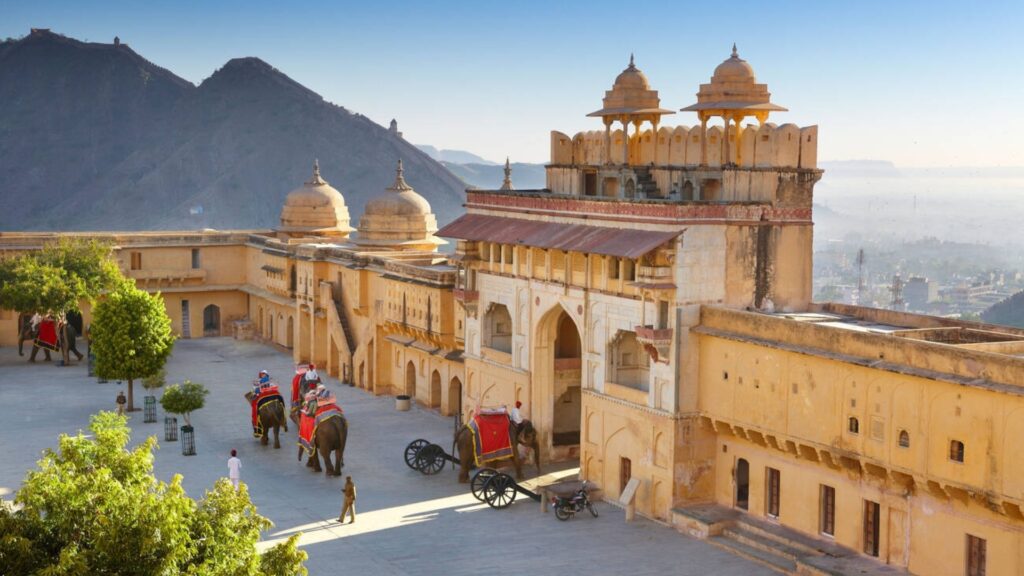
A majestic fort located on a hilltop, offering panoramic views of the surrounding landscape. Don’t miss the intricate carvings, mirror work, and the stunning Sheesh Mahal (Mirror Palace).
Hawa Mahal
Also known as the “Palace of Winds,” this iconic structure is famous for its intricate facade with over 900 windows, designed to allow royal ladies to observe street festivities while remaining unseen.
City Palace
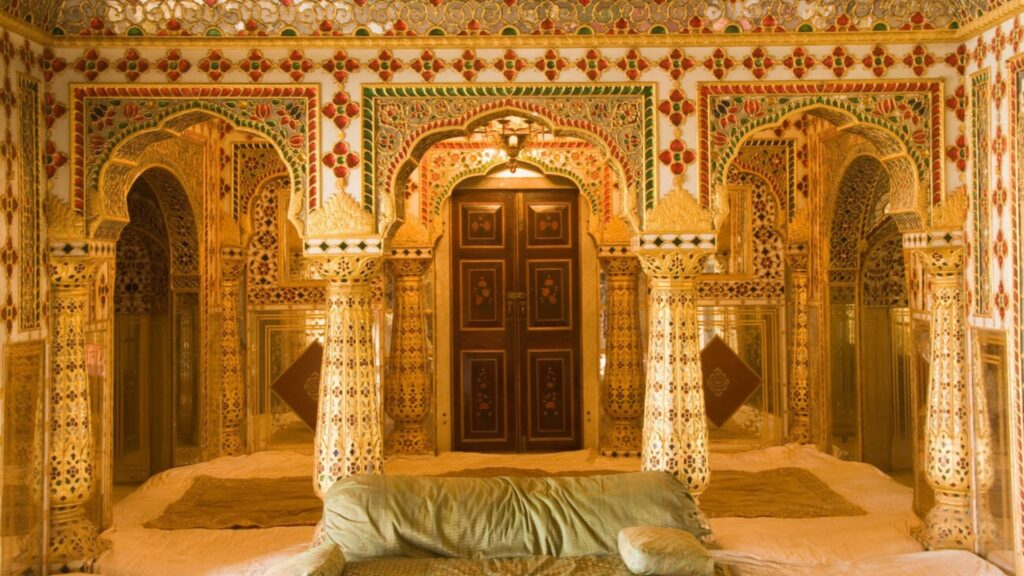
An amazing complex showcasing a blend of Rajasthani and Mughal architecture. Explore the various courtyards, museums, and the stunning Chandra Mahal.
Jantar Mantar
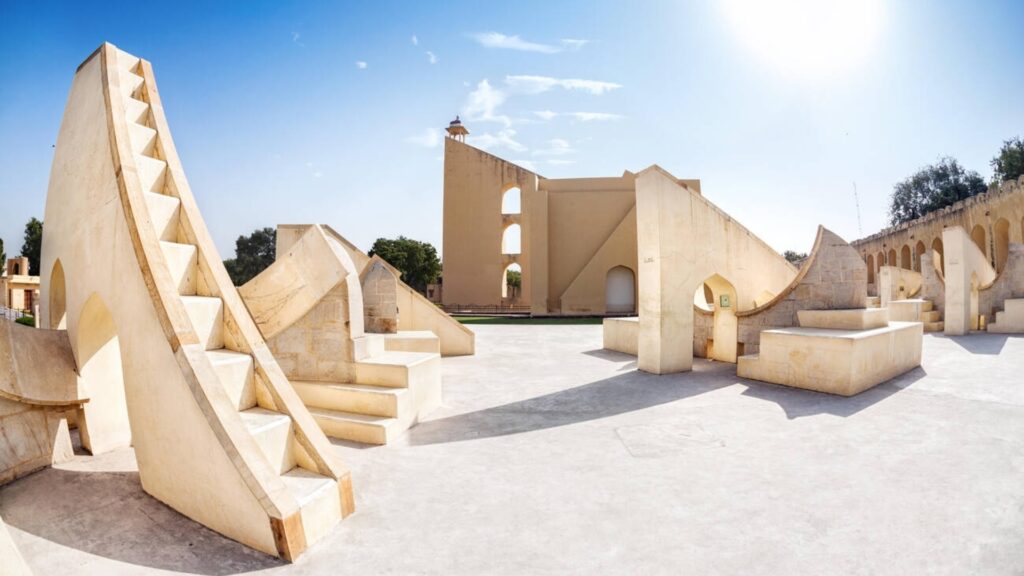
A UNESCO World Heritage Site, Jantar Mantar is an astronomical observatory built in the 18th century. It houses various ancient things used for measuring time, predicting eclipses, and tracking celestial bodies.
Jaigarh Fort

Situated on a hilltop overlooking the Amber Fort, Jaigarh Fort is known for its massive cannon, Jaivana, which is believed to be the world’s largest cannon on wheels.
Nahargarh Fort

Another popular hilltop fort offering panoramic views of Jaipur city. Enjoy the scenic surroundings and visit the Madhavendra Bhawan, a series of palatial suites within the fort.
Albert Hall Museum
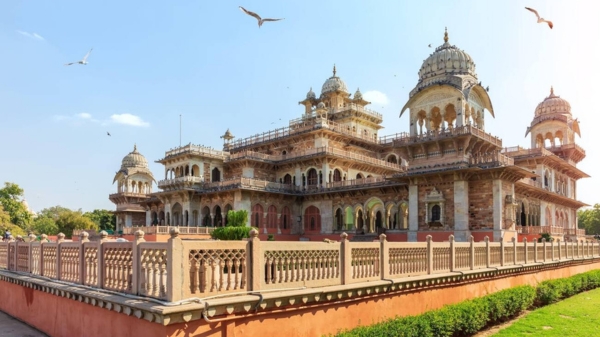
Housed in a stunning Indo-Saracenic building, the museum showcases a vast collection of artifacts, including textiles, paintings, sculptures, and arms and armor.
Jal Mahal

A beautiful palace located in the middle of Man Sagar Lake. While the palace is not open to the public, you can enjoy its beauty from the banks of the lake.
Galtaji (Monkey Temple)
An ancient temple complex surrounded by hills and inhabited by a large population of monkeys. Explore the various temples, natural springs, and stunning architecture.
Birla Mandir
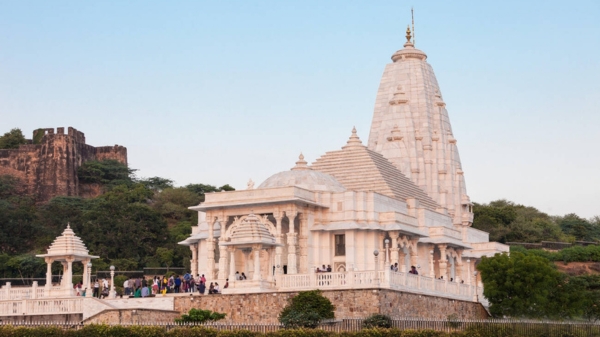
A beautiful temple dedicated to Lord Vishnu and Goddess Lakshmi, known for its intricate marble carvings and serene ambiance.
These are just a few of the many attractions that Jaipur has to offer. The city is also known for its bustling bazaars, delicious cuisine, and vibrant cultural heritage, making it a must-visit destination in India. If you want to combine pilgrimage and adventure both, then Pushkar is another attractive place in Rajasthan. Where you can enjoy adventure along with pilgrimage.
Amazing Facts About Jaipur, Rajasthan
Here are some amazing facts about Jaipur, Rajasthan:
here are some amazing facts about Jaipur, Rajasthan to explore:
• Jaipur, the Pink City, was painted pink in 1876 to welcome the Prince of Wales.
• Jaipur’s layout follows Vedic architectural principles.
• Home to the Jantar Mantar, one of the largest astronomical observatories in the world.
• The Amber Fort showcases a blend of Rajput and Mughal architecture.
• Nahargarh Fort offers panoramic views of the city and serves as a popular filming location.
• Hawa Mahal, with its 953 windows, is an iconic symbol of Jaipur’s heritage.
• Jaipur’s Elephant Festival during Holi features beautifully adorned elephants in parades.
• City Palace showcases a fusion of Rajput, Mughal, and European architectural styles.
• Jaipur hosts traditional performing arts like Kathak and puppetry.
• The Jaipur Literature Festival at Diggi Palace attracts renowned authors and intellectuals around the globe.
• The Jaipur Metro, inaugurated in 2015, eases traffic congestion in the city.
In Jaipur, every corner tells a story, and every moment is filled with wonder. It’s a place where history, culture, and beauty come together to create an experience you’ll never forget.
Local Cuisine: You Must Try
Let’s explore some of the delightful local cuisines you must try when visiting Jaipur, Rajasthan
Dal Baati Churma: A plate filled with small, round dough balls (baatis) served with a rich and flavorful lentil curry (dal) alongside a sweet crumbly mixture made of wheat, ghee (clarified butter), and sugar (Churma).
Ghewar: Ghewar is a traditional Rajasthani dessert that looks like a delicate honeycomb. It’s made from flour, ghee, and sugar syrup, then garnished with almonds, pistachios, and sometimes even edible silver foil.
Laal Maas: Laal Maas literally translates to “red meat,” and it’s a fiery and flavorful dish that’s a staple in Rajasthani cuisine.
Kachori: Picture a golden, crispy pastry filled with a spicy mixture of lentils, spices and sometimes potatoes or peas. The combination of the crunchy outer shell and the flavorful filling makes it a must-try street food in Jaipur.
Mirchi Vada: Mirchi Vada is a popular street food snack that packs a spicy punch. It consists of green chili peppers stuffed with a tangy potato mixture, coated in a chickpea flour batter, and deep-fried until golden brown.
Mawa Kachori: This is a sweet variation of the classic kachori. Imagine a soft, flaky pastry filled with a rich mixture of khoya (reduced milk solids), nuts and aromatic spices, then deep-fried to golden perfection.
Pyaz Kachori: Another variation of the beloved kachori is the pyaz kachori, which features a crispy shell filled with a spicy onion mixture.
Rajasthani Thali: This traditional meal consists of a variety of dishes served on a large platter, including dal, bati, Churma, assorted vegetable curries, roti (flatbread), rice, pickles, and papad.
Malai Ghewar: Malai Ghewar is a decadent variation of the classic ghewar dessert. It features the same crispy honeycomb-shaped base, but it’s topped with a luscious layer of malai (clotted cream) and garnished with nuts and saffron.
Rabri: Rabri is a traditional Rajasthani dessert made by boiling milk until it’s thick and creamy, then sweetening it with sugar and flavoring it with cardamom and saffron.
Each of these dishes offers a unique taste of Rajasthan’s rich culinary heritage, with flavors and aromas that will transport you to the vibrant streets of Jaipur. So don’t miss the opportunity to savor these delightful delicacies and experience the true essence of Rajasthani cuisine during your visit to Jaipur!
How To Reach
To reach Jaipur from national capital of India, Delhi, travelers have multiple options. The most common is by road, with a distance of approximately 280 kilometers, reachable via NH48. Alternatively, one can opt train service, with several trains departing from New Delhi Railway Station to Jaipur Junction daily. The journey by train takes around 4 to 6 hours. For those preferring air travel, Jaipur International Airport offers frequent flights from Indira Gandhi International Airport in Delhi, with a flight duration of about 1 hour.
Where To Stay In Jaipur, Rajasthan
here are some places details on where to stay in Jaipur, Rajasthan:
Budget Accommodation/ Mid-range Hotels: If you’re looking for affordable options, there are plenty of budget hotels, guesthouses, and hostels available in Jaipur. You can find budget stays in areas like MI Road, Bani Park and Sindhi Camp.
- House of Touristers Hotel
Artbuzz Jaipur
Hotel Zamarrud Palace
Haveli of Jaipur Hotel
Heritage Havelis and Boutique Hotels: Experience the charm of Jaipur’s heritage by staying in a traditional haveli (mansion) or boutique hotel. These accommodations are often converted from old palaces or mansions, offering a unique blend of history and luxury. Look for heritage havelis and boutique hotels in areas like Amer Road, Johari Bazaar, and Rambagh.
- Umaid Bhawan : A heritage style boutique hotel
Dera Rawatsar
Laxmi Palace -Heritage boutique hotel
Alsisar Haveli
Luxury Resorts And Palaces: Indulge in luxury by staying at one of Jaipur’s opulent resorts or palace hotels. These properties offer world-class amenities, exquisite architecture, and impeccable service.
Some famous luxury resorts and palaces in Jaipur include the
- Rambagh Palace,
- Taj Jai Mahal Palace
- Oberoi Rajvilas
- Dileep Kothi
Homestays And Airbnb: For a more authentic and personalized experience, consider staying in a homestay or booking accommodation through Airbnb. You’ll have the opportunity to interact with local hosts, experience Rajasthani hospitality firsthand and get insider tips on exploring Jaipur. Homestays and Airbnb options are available in various neighbourhoods across the city, offering a cozy and welcoming atmosphere.
Whether you’re a budget traveler, a luxury seeker, or someone looking for a unique cultural experience, Jaipur has a wide range of accommodation options to suit every preference and budget. Just choose the type of stay that best fits your needs and enjoy your time in the Pink City!







Leave a reply